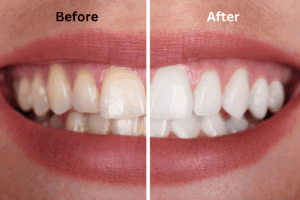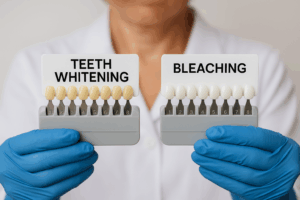If you’re comparing teeth whitening vs. bleaching, you’re not alone. One of the most frequent questions I’ve gotten for years concerns how to safely get a brighter smile—and whether whitening and bleaching are truly different.
Having brighter teeth has nearly become a national obsession. The popularity of this relatively simple procedure has been fueled by national advertising, social media, TV makeover programs, and people’s natural desire for a more attractive smile.
Some of the most common questions patients ask include:
- Does bleaching work?
- Will it work for me?
- Will it hurt my teeth to whiten them—or damage them?
- Is it painful?
- Do whitening strips work?
- How long does it take?
- How much does it cost?
- Is there a difference between teeth whitening vs. bleaching?
What’s the Difference Between Teeth Whitening and Bleaching?
Practically speaking, people use both terms to mean “making teeth look brighter.” Technically, the distinction comes from how products are classified:
- Whitening can refer to anything that helps remove surface stains and makes teeth look cleaner (e.g., toothpaste or polishing agents).
- Bleaching typically means using agents (like carbamide or hydrogen peroxide) that can lighten beyond the tooth’s natural shade.
Because “whitening” sounds gentler, many products use that term—even if they are designed to lighten beyond the natural color. This is partly why searches like teeth whitening vs. bleaching are so common: the labeling can be confusing.
How Much Does Teeth Whitening Cost?
Costs vary depending on the method and your goals:
- Over-the-counter strips purchased at or through a dental office can be the least expensive (roughly $20–$100), but results are typically modest unless your teeth are already fairly bright.
- Professionally dispensed custom trays generally range about $100–$500 and give more predictable, even results because the trays fit your teeth precisely and keep the gel where it’s needed.
- In-office bleaching often averages around $650 per visit nationally; it’s supervised and can jump-start difficult cases.
How Long Does Whitening or Bleaching Take?
The duration of results often surprises patients comparing teeth whitening vs. bleaching, because each method works at a different depth within the enamel.
It depends on several factors:
- Age: Younger patients often respond faster.
- Enamel thickness/translucency: Thicker, less translucent enamel may respond differently than thin/translucent enamel.
- Starting shade: Yellow-brown tones usually lighten more readily than gray or banded discolorations.
- Dietary habits: Coffee, tea, red wine, colas, and smoking can re-stain more quickly.
- Medication-related stains: Tetracycline and high-fluoride exposures during enamel formation can be more resistant.
- Functional habits: Grinding/clenching can thin enamel and create microcracks that harbor stains, making results less uniform.
Typical timeline: With custom trays, many patients see noticeable change in about 1 week, with average courses taking ~2 weeks; difficult cases can require 3+ weeks.
Do Whitening Strips Really Work?
They can help in mild cases, but they’re not custom-fitted. A precise tray keeps the gel in consistent contact with enamel and away from gums. Strips can wrinkle or fold, and some users find them cumbersome. For uniform coverage and predictability, custom trays win.
Does Teeth Whitening Hurt?
Some people experience temporary sensitivity to temperature and pressure. It’s usually transient and subsides quickly; in some cases, it can persist for a few weeks. Gum irritation can occur if gel contacts tissue—well-designed trays reduce that risk.
Clinical note: Some clinicians anecdotally report a higher sensitivity rate among natural redheads—this isn’t a rule, just an observation to keep in mind when planning comfort strategies.
Is Teeth Whitening Safe for Enamel?
When professionally supervised and used as directed, peroxide-based agents have not been shown to harm enamel structure. Always follow your dentist’s protocol regarding strength, wear time, and aftercare.
For a balanced overview of safety, see authoritative resources such as the
American Dental Association and
Cleveland Clinic.
Tips for the Best Whitening Results
These tips can maximize comfort and results for anyone considering teeth whitening vs. bleaching treatments.
- Use the right strength and wear time—as prescribed.
- Wipe or brush away excess gel to avoid gum irritation.
- Pause treatment and inform your dentist if sensitivity spikes; desensitizing gels or shorter sessions usually solve it.
- Limit strong chromogens (coffee, tea, red wine) during active whitening; resume in moderation after stabilization.
- Maintain with periodic touch-ups; your dentist can recommend a schedule.
Choosing Between Teeth Whitening vs. Bleaching
For everyday stain removal and a small shade lift, “whitening” approaches (pastes/polishing) help.
For a true shade change beyond your natural baseline, professional “bleaching” with peroxide-based gels—via custom trays and/or in-office care—delivers the most predictable, even results.
Where to Learn More and Support Your Oral Wellness
- Explore professional-grade oral care supplements and essentials via my dispensary: ToothWiz Vitamins (managed by Fullscript).
- If you’re setting up a Fullscript account specifically for my recommendations and easy ordering, start here: Fullscript Signup.
For further background reading, see a concise research overview via PubMed on bleaching safety
(Tooth whitening safety review).
About Dr. Richard Walicki
Dr. Richard Walicki practices in Altadena, California and also provides care across Southern California in a mobile setting. His current clinical focus includes prosthetics and a significant amount of oral surgery (extractions)—work that helps vulnerable patients regain comfort and function. Drawing on decades of restorative and cosmetic experience, he helps patients understand the real differences in teeth whitening vs. bleaching, set healthy expectations, and choose safe, sensible paths to a brighter smile.
Understanding teeth whitening vs. bleaching empowers you to choose the safest, most effective path toward a confident smile.





